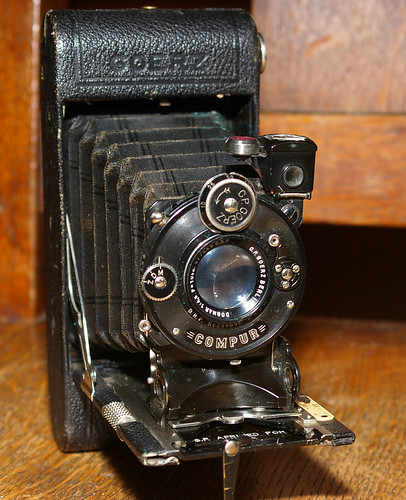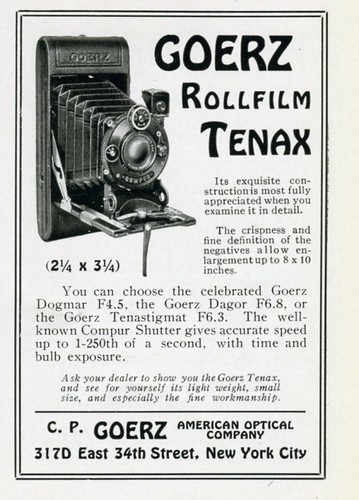Difference between revisions of "Rollfilm Tenax"
m (correcting Collection Appareils link) |
(Corrected date; ref to McKeown, and more about other sizes from McK. Other minor edits. Margin on top picture. +Cats) |
||
| Line 1: | Line 1: | ||
| + | <div class="floatleft plainlinks" style="margin:0px 15px 15px 0px;"> | ||
{{Flickr image | {{Flickr image | ||
| image_source=http://www.flickr.com/photos/nesster/5412434547/in/pool-camerawiki | | image_source=http://www.flickr.com/photos/nesster/5412434547/in/pool-camerawiki | ||
| image=http://farm5.static.flickr.com/4135/5412434547_699d56f0ec.jpg | | image=http://farm5.static.flickr.com/4135/5412434547_699d56f0ec.jpg | ||
| − | | image_align= | + | | image_align= |
| − | | image_text= | + | | image_text= 6x9 cm Rollfilm Tenax |
|image_by= Nesster | |image_by= Nesster | ||
| − | |image_rights= | + | |image_rights= with permission |
}} | }} | ||
| + | </div> | ||
| + | The '''Rollfilm Tenax''' (sometimes '''Roll-Tenax''') is a series of folding bed cameras for roll film, made by [[Goerz]] in Berlin. A plate adapter could also be had as an accessory for at least some of these cameras. The cameras are metal-bodied with black leather bellows and covering. | ||
| − | The ''' | + | The first cameras were made in about 1909.<ref name=McK>{{McKeown12}} p356-7. McKeown lists some of the later models as 'Roll-Tenax'.</ref> These early models are for ''large'' roll film; McKeown lists two models (single and double bellows-extension) in 8x10.5 cm size, and two in 8x14 cm.<ref name=McK/> A much smaller model, the '''Roll-Pocket Tenax'''<ref>There are also a Vest-Pocket Tenax (a ''strut''-folding camera for 4.5x6 cm plates) and a ''Coat''-Pocket Tenax again, strut-folding, for 6.5x11 cm plates), from around the same time.</ref> for 4.5x6 cm pictures on 127 film, was introduced about 1914. These cameras were available with various Goerz lenses including the Dagor, and shutters including the Ibso and Compound (and later Compur). |
| + | |||
| + | New models, also covering intermediate sizes (4.5x6 cm, 6x9 cm, 6.5x11 cm, 8x10.5 cm and 8x14 cm), was introduced in about 1920.<ref name=McK/>. These cameras have the interesting focusing 'barrel' on the right side of the bed; earlier models have a more conventional knurled wheel at the front corner. | ||
| + | |||
| + | The camera illustrated is the 6x9 cm (2¼x3¼ inch) model, with a [[Compur]] shutter giving speeds 1, 1/5, 1/10, 1/25, 1/50, 1/100 and 1/250 seconds in M (moment) mode, plus Z (time) and D (bulb) mode. The lens is a Goerz Dogmar 10 cm f/4.5; it might also be an f/6.3 Dogmar or Tenastigmat, or an f/6.8 [[Dagor]]. The lensboard is hinged to the standard, so that the standard remains connected to the rails on the folding bed when the bellows is collapsed and the camera closed. When opened and unfolded the standard and lensboard are locked in place; focusing is by shifting the rails forward by means of the knurled barrel in the side of the bed. On the other side is a distance scale and pointer. The camera has just a [[brilliant finder]] of less than "WYSIWYG" quality. Some Rollfilm Tenaxes have the finder combined with a spirit level. | ||
| + | |||
| + | <br style="clear:left;"/> | ||
{{Flickr image | {{Flickr image | ||
| Line 14: | Line 23: | ||
| image=http://farm6.static.flickr.com/5017/5413054770_4eebf1bb07.jpg | | image=http://farm6.static.flickr.com/5017/5413054770_4eebf1bb07.jpg | ||
| image_align=right | | image_align=right | ||
| − | | image_text= | + | | image_text= US advertisement, 1921 |
|image_by= Nesster | |image_by= Nesster | ||
|image_rights= with permission | |image_rights= with permission | ||
}} | }} | ||
| − | + | ==Notes== | |
| + | <references/> | ||
| + | |||
==Links== | ==Links== | ||
| Line 26: | Line 37: | ||
[[Category:Goerz]] | [[Category:Goerz]] | ||
| − | [[Category: | + | [[Category: German 4.5x6 viewfinder folding]] |
| + | [[Category: German 6x9 viewfinder folding]] | ||
| + | [[Category: 6.5x11 folding]] | ||
| + | [[Category: 8x10.5 folding]] | ||
| + | [[Category: 8x14 folding]] | ||
| + | [[Category:1906-1910]] | ||
| + | [[Category: 1920]] | ||
Revision as of 14:01, 20 May 2012

|
| 6x9 cm Rollfilm Tenax image by Nesster (Image rights) |
The Rollfilm Tenax (sometimes Roll-Tenax) is a series of folding bed cameras for roll film, made by Goerz in Berlin. A plate adapter could also be had as an accessory for at least some of these cameras. The cameras are metal-bodied with black leather bellows and covering.
The first cameras were made in about 1909.[1] These early models are for large roll film; McKeown lists two models (single and double bellows-extension) in 8x10.5 cm size, and two in 8x14 cm.[1] A much smaller model, the Roll-Pocket Tenax[2] for 4.5x6 cm pictures on 127 film, was introduced about 1914. These cameras were available with various Goerz lenses including the Dagor, and shutters including the Ibso and Compound (and later Compur).
New models, also covering intermediate sizes (4.5x6 cm, 6x9 cm, 6.5x11 cm, 8x10.5 cm and 8x14 cm), was introduced in about 1920.[1]. These cameras have the interesting focusing 'barrel' on the right side of the bed; earlier models have a more conventional knurled wheel at the front corner.
The camera illustrated is the 6x9 cm (2¼x3¼ inch) model, with a Compur shutter giving speeds 1, 1/5, 1/10, 1/25, 1/50, 1/100 and 1/250 seconds in M (moment) mode, plus Z (time) and D (bulb) mode. The lens is a Goerz Dogmar 10 cm f/4.5; it might also be an f/6.3 Dogmar or Tenastigmat, or an f/6.8 Dagor. The lensboard is hinged to the standard, so that the standard remains connected to the rails on the folding bed when the bellows is collapsed and the camera closed. When opened and unfolded the standard and lensboard are locked in place; focusing is by shifting the rails forward by means of the knurled barrel in the side of the bed. On the other side is a distance scale and pointer. The camera has just a brilliant finder of less than "WYSIWYG" quality. Some Rollfilm Tenaxes have the finder combined with a spirit level.

|
| US advertisement, 1921 image by Nesster (Image rights) |
Notes
- ↑ 1.0 1.1 1.2 McKeown, James M. and Joan C. McKeown's Price Guide to Antique and Classic Cameras, 12th Edition, 2005-2006. USA, Centennial Photo Service, 2004. ISBN 0-931838-40-1 (hardcover). ISBN 0-931838-41-X (softcover). p356-7. McKeown lists some of the later models as 'Roll-Tenax'.
- ↑ There are also a Vest-Pocket Tenax (a strut-folding camera for 4.5x6 cm plates) and a Coat-Pocket Tenax again, strut-folding, for 6.5x11 cm plates), from around the same time.